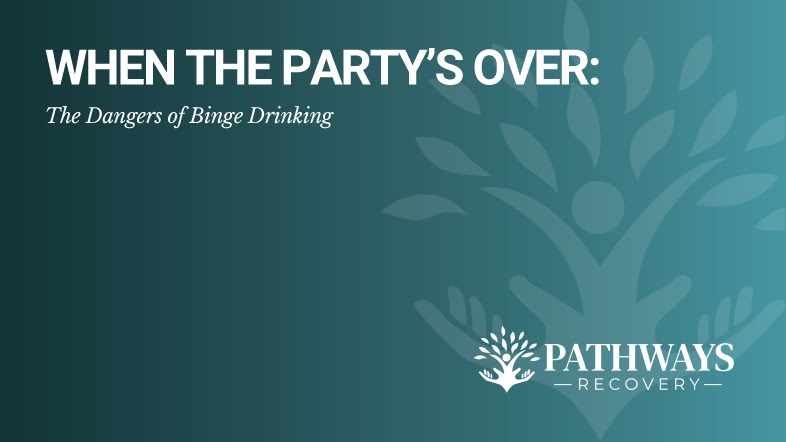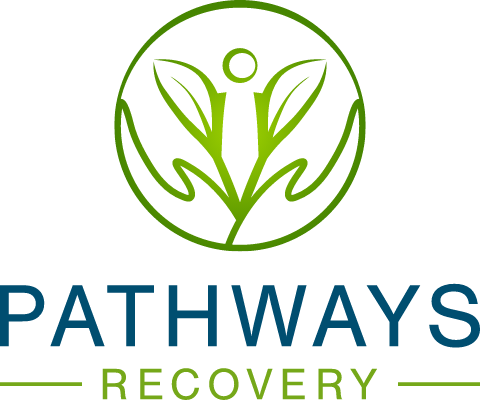When the Party’s Over: The Dangers of Binge Drinking
If you believe someone has alcohol poisoning, call 911 immediately.
It’s no secret our country has a drinking problem. Seriously. Think about it. Even at a young age, for most of us, alcohol seemed to be everywhere. It was referenced in the movies we watched, the music we listened to, and the schools we attended.
Drinking has become a common way to socialize, relax, or simply pass the time. For most of us, we’ll be fine managing our alcohol consumption. But the reality is that some people just can’t. And that’s OK. Drinking isn’t for everyone. We’re all different and unique. What’s right for you may not be right for me, and vice versa.
Unfortunately, there’s also a common, unhealthy pressure that comes along with drinking. Most people feel anxious about being the one person without a beer in their hand, or the one person not taking a celebratory shot.
Another problem with our drinking culture is that it lays the perfect foundation for dangerous habits. While not everyone who drinks regularly will develop an alcohol use disorder, many Americans still binge drink. In fact, according to the Centers for Disease Control and Prevention (CDC), one in six adults in the United States binge drinks about four times per month.
To be even more specific, while binge drinking is common among adults ages 18-34, more than half of the total binge drinks are consumed by those 35 and older. Also, young people under the age of 21 often consume large amounts.
While binge drinking may seem like a normal night out (or in), it can be dangerous.
What Is Considered Binge Drinking?
Binge drinking is currently the most common, costly, and one of the most dangerous patterns of alcohol misuse in the United States. It also affects people from all walks of life, regardless of gender, race, or age.
According to the CDC, “Binge drinking is defined as a pattern of drinking that brings a person’s blood alcohol concentration (BAC) to 0.08 or above. This typically happens when men consume five or more drinks or women consume four or more drinks in about two hours. Most people who binge drink do not have a severe alcohol use disorder.“
As mentioned previously, one in six adults in the U.S. binge drinks at least four times a month. On average, they consume around seven drinks per binge. This results in 467 binge drinks every year per person who binge drinks. Across the United States, there are 17 billion total binge drinks consumed by adults every year.
The CDC reports binge drinking is most common among men and people with household incomes of $75,000 or more and higher education levels. On the other hand, binge drinkers with lower incomes and education levels consume more binge drinks per year.
The Dangers of Binge Drinking
What you’ve heard is true: Too much alcohol can be dangerous. If you’re partying or just enjoying an evening, it’s easy to lose count of how much you’re drinking. You can refer to the CDC’s definition of binge drinking earlier in this blog post.
Furthermore, the CDC says there are many health problems associated with binge drinking, including:
- Unintentional injuries from car crashes, alcohol poisoning, falls, and burns
- High blood pressure
- Stroke
- Heart disease
- Liver disease
- Cancer of the breast, mouth, throat, esophagus, liver, or colon
- Memory problems
- Learning problems
- Violence
- Alcohol use disorder
Binge drinking has also been shown to cost everyone. In 2010, binge drinking cost the United States $249 billion as a result of losses from criminal justice costs, lost workplace productivity, and healthcare costs.
Proposed Strategies to Prevent Binge Drinking
There are a few recommended strategies proposed by government entities to prevent binge drinking. According to the CDC, evidence-based interventions include:
- Increasing alcohol taxes
- Limiting the number of retail alcohol outlets
- Holding alcohol retailers responsible for harms caused by selling alcohol to intoxicated persons and minors
- Restricting access to alcohol by maintaining limits on days and hours in which alcohol can be sold
- Enforcing underage drinking laws
- Enforcing alcohol-impaired driving laws
- Maintaining government control on alcohol sales
You can also help. By applying a few strategies, you can assist in reducing binge drinking statistics. You can:
- Choose not to drink too much and help others do the same
- Have no more than one drink per day if you’re a woman
- Have no more than two drinks per day if you’re a man
- Not serve alcohol to those under the age of 21
- Not serve alcohol to those with an alcohol use disorder
- Talk to your healthcare provider about your drinking habits
If you believe binge drinking has led to a more serious issue, such as alcohol use disorder, for you or a loved one, being able to recognize the signs can be very helpful.
Identifying Alcohol Use Disorder
The U.S. National Library of Medicine (NLM) explains, “For most adults, moderate alcohol use is probably not harmful. However, about 18 million adult Americans have an alcohol use disorder (AUD). This means that their drinking causes distress and harm. AUD can range from mild to severe, depending on the symptoms. Severe AUD is sometimes called alcoholism or alcohol dependence.”
AUD can cause intense cravings for alcohol, the inability to stop drinking once you’ve started, and feelings of distress when you’re not drinking.
Like any disorder, there are a few telltale signs that you may be experiencing AUD. The following are all symptoms:
- Drinking more or longer than you intended
- Spending free time drinking
- Drinking is interfering with your personal and/or professional life
- You’ve abandoned activities you once enjoyed for drinking
- You continue drinking despite the negative impact on your physical and mental health
- Troubles with the law due to drinking
- Having to drink more and more to achieve the desired effects
- Wanting to stop drinking but being unable to
- Experiencing withdrawal symptoms when you aren’t drinking
If you or someone you know is experiencing any of these symptoms, you should visit your healthcare provider for an evaluation. The NLM says the more symptoms of AUD you have, the more serious the issue is.
The Dangers of Alcohol Poisoning
If you believe someone has alcohol poisoning, call 911 immediately.
Alcohol poisoning, sometimes referred to as alcohol overdose, occurs when there is so much alcohol in the bloodstream that certain areas of the brain begin to shut down. These areas of the brain control life-sustaining functions such as breathing, temperature, and heart rate.
By taking other substances with alcohol, such as opioids or sedatives, the chances, and dangers of alcohol poisoning increase.
Also, according to the National Institutes of Health, “Teenagers and young adults who drink may be at particular risk for alcohol overdose. Research shows that teens and college-age young adults often engage in binge drinking and high-intensity drinking. Drinking such large quantities of alcohol can overwhelm the body’s ability to break down and clear alcohol from the bloodstream.”
Symptoms of alcohol poisoning include:
- Mental confusion
- Vomiting
- Seizure
- Breathing problems
- Rapid heart rate
- No gag reflex (prone to choking)
- Low body temperature
- Inability to remain conscious (awake)
Alcohol poisoning can be fatal or lead to permanent brain damage.
Symptoms of Alcohol Withdrawal
Withdrawal occurs when someone who drinks heavily or has AUD suddenly stops drinking. Typically, alcohol withdrawal begins within eight hours of the last drink, according to the NLM. Symptoms usually peak after a few days, but they can last for weeks.
Symptoms might include:
- Depression
- Fatigue
- Anxiety
- Mood swings
- Nightmares
- Headache
- Loss of appetite
- Insomnia (sleeplessness)
- Nausea
- Vomiting
- Rapid heart rate
- Sweating
- Irritability
- Agitation
- Fever
- Confusion
- Hallucinations (seeing or hearing things that aren’t there)
- Seizures
In some cases, these symptoms can be quite severe. If you or someone you know has a severe alcohol use disorder, professional treatment is typically the best route to take.
Help Is Out There
No one should have to face their struggles with alcohol alone. If you are struggling with binge drinking or alcohol use disorder, help is out there.
By seeking professional alcoholism treatment, you can learn what it takes to live a sober life. Remember, you deserve it.
The first step is usually the most difficult one to make, but it’s the most important one on the road to recovery. You have what it takes.
You Have the Power to Overcome
Pathways Recovery, in Sacramento CA, provides three levels of addiction treatment solutions for those battling alcohol use disorder, including a detox center, residential treatment, and intensive outpatient treatment.
The facility is designed to provide the best possible experience for clients as they work towards recovery. Pathways Recovery clients will work tirelessly to make sure each client is safe and well taken care of.
The detox center provides medically assisted detoxification for those who need it. Our clients will be supported through this entire process with a qualified team available to provide supervision for safety and peace of mind.
After the detox process, clients will enter the residential program to begin the healing process. Pathways Recovery, in Sacramento, CA, treatment programs are tailored to the unique needs of the client.
Therapy sessions are designed to get to the root cause of addiction, psychiatry to focus on undiagnosed mental health disorders, and medication-assisted treatment is available if the client needs it.
The third and final part of the process is intensive outpatient treatment, which is perfect for clients transitioning from their residential stay. With three weekly group sessions available, clients can remain connected to the recovery process.
Pathways Recovery is Northern California’s finest men’s only addiction treatment center. To learn more, call (916) 735-8377.
Frequently Asked Questions
What is the CDC’s definition of binge drinking?
The CDC says, “Binge drinking is defined as a pattern of drinking that brings a person’s blood alcohol concentration (BAC) to 0.08 or above. This typically happens when men consume five or more drinks or women consume four or more drinks in about two hours. Most people who binge drink do not have a severe alcohol use disorder.”
What is alcohol use disorder?
Per the National Library of Medicine, alcohol use disorder (AUD) is drinking that causes distress and harm. AUD can range from mild to severe, depending on the symptoms. Severe AUD is sometimes called alcoholism or alcohol dependence. AUD can cause intense cravings for alcohol, the inability to stop drinking once you’ve started, and feelings of distress when you’re not drinking.
What is alcohol poisoning?
Alcohol poisoning occurs when there is so much alcohol in the bloodstream that certain areas of the brain begin to shut down. These areas of the brain control life-sustaining functions such as breathing, temperature, and heart rate. This can be dangerous. If you suspect someone may have alcohol poisoning, call 911 immediately.




